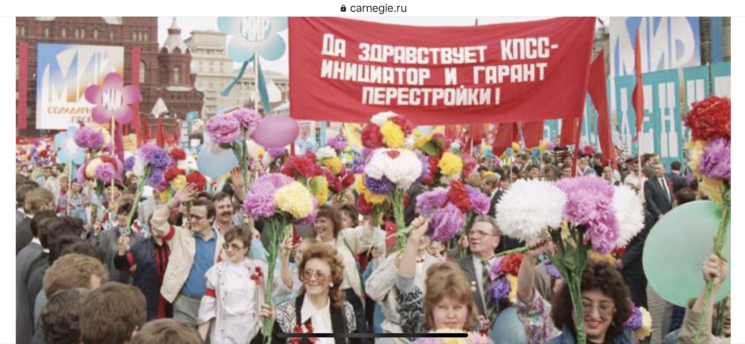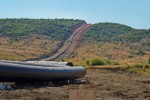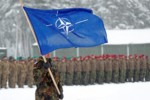May Day demonstration marches on Red Square. 1989. Photo: Yuri Lizunov/TASS
Russian President Vladimir Putin has always embraced the idea that he rules Russia not with an iron fist but with a light touch and that he is the unchallenged leader of his country because the public puts its trust in him. Now, by declaring his intention to stay in power almost indefinitely, Putin has broken that unwritten pact with the Russian public. But it is hard to know exactly what is driving Putin. After all, it has been nearly six months since the launch of a constitutional reform process that even Kremlin loyalists had interpreted as the start of a search for a successor in 2024—and that turned out to be a giant facade.
Putin’s flamboyant change of heart created unexpected tensions with Russia’s political class. For the upper echelons of the Russian elite, the “2024 problem” was never about Putin. It was about holding on to power themselves. Before Putin’s hasty decision to amend the constitution, these elite groups were busily anticipating a world in which they could maintain their collective power without Putin occupying the post of president.
Of course, Putin’s perspective counted far more than theirs. As far as the president was concerned, Putin’s Russia was synonymous with Putin the individual: there is no one else who can drive the machine. So, he rejected the complicated constitutional maneuvers suggested by his advisers for 2024 and chose the simplest and crudest solution—to stay on as president.
AVOIDING GORBACHEV'S MISTAKES
Why did Putin reverse the decision he apparently made in January? To answer this, observers must examine the president’s views on Russia’s twentieth-century history and the legacy he inherited from his two predecessors, former presidents Boris Yeltsin and Mikhail Gorbachev. Putin is seeking to avoid the mistakes of perestroika, or the Soviet Union’s political, economic, and social restructuring of the late 1980s into the early 1990s. He is afraid of ushering in a perestroika 2.0.
Even though he makes approving remarks about the achievements of the Soviet epoch, Putin is not a nostalgist seeking a restoration. The man who back in 2005 called the end of the Soviet Union “the great geopolitical catastrophe of the era” also said that “whoever wants to restore it in its previous form has lost his head.”
Putin is more calculating. Like many former Soviet bureaucrats, he knows from bitter firsthand experience how and why a superpower like the Soviet Union met such a quick demise between 1985 and 1991. His thinking differs from the Orthodox Communists or die-hard Soviet nostalgists who have a ready-made explanation: the debacle was entirely the result of “Gorbachev’s treachery.” Putin is not a hard-line conspiracy theorist who believes that Gorbachev personally and deliberately made a fateful pact with the West to bring the country crashing down. Rather, he appears to share the view that Gorbachev is culpable because he did not properly protect the core institutions of the country as crisis overtook it. The failure is seen as a broader one—of the collective leadership in the later Soviet period. And, this line of thinking goes, the disastrous consequences are still very much being felt today.
In 2020, the perestroika issue is salient again. Putin and many of his advisers are aware that some kind of reform is needed, just like it was in 1985. But what exactly can be done to lift Russia from its current economic slump and overdependence on hydrocarbons? The language the ruling regime uses to discuss this is very cautious to avoid the appearance that Putin has any fault.
 A picture taken on March 26, 1989 in Moscow shows General Secretary of the Communist Party of the Soviet Union Mikhail Gorbachev talking to Western reporters. Source: Getty
A picture taken on March 26, 1989 in Moscow shows General Secretary of the Communist Party of the Soviet Union Mikhail Gorbachev talking to Western reporters. Source: Getty
Reflecting a change in public mood, Russia’s elites have stopped using the word “stability,” which for years was their main slogan. This slogan originally emphasized the security and prosperity that Putin was said to have delivered after the volatile 1990s. But now, opinion survey data show that the Russian public no longer values “stability” and the status quo as much as it did a few years ago. The public is increasingly hungry for change.
But the word “reform” is banned from the elites’ political vocabulary, and no one dares to blame Putin for his role in creating these economic problems over the past two decades. This is why Putin has started to use the word proryv, or “breakthrough”—a slogan that Russian society has not taken to heart.
This does not entirely solve the problem, however. The substitution of “breakthrough” instead of “stability” still suggests a break with the past. It will remind many Russians of one of Gorbachev’s slogans of the mid-1980s: “acceleration,” a call to restart the motor of the Soviet system after years of “stagnation” under former Soviet leader Leonid Brezhnev.
The limiting factor now is that Putin and his inner circle fear change could get out of hand. Gorbachev, after all, became so impatient with the state of the nation that he enacted bold political reforms to promote glasnost, or a political opening. In 1989, he assembled the Congress of People’s Deputies, the Soviet Union’s first elected parliament, as a way of breaking the Communist Party’s stranglehold on his reform agenda. But “acceleration” quickly became a ride that took the country into the unknown at breakneck speed. Gorbachev and his team lost control of the process that they had started, and the vehicle they were driving crashed.
Putin and his close advisers harbor fears that they could unleash similar centripetal forces and lose control of the political processes they have charted for 2024.
LESSONS OF THE TANDEM
Putin has already had one experience of handing over power to a successor, when he bowed to constitutional term limits and allowed his adviser and friend Dmitry Medvedev to take over as president in 2008. Putin moved sideways to be prime minister, which had the added benefit of separating Putin from the formal duties of head of state that had grown tiresome.
It became obvious that Putin’s experience of the “tandem” with Medvedev between 2008 and 2012 was not a happy one. The arrangement between the two men rested entirely on informal agreements, not on formal obligations set in stone. Medvedev stayed loyal, but under the constitution, he retained, formally at least, the right to dismiss his prime minister.
The big problem, from Putin’s point of view, emerged as Medvedev’s presidential term was due to end and decisions had to be made about who would be Russia’s next president in 2012.
Those who took part in the street protests that rocked Moscow in 2011–2012 portrayed the demonstrations as a spasm of anger at Putin’s heavy-handed and humiliating decision to return to the Kremlin. Putin and his inner circle saw the protests as a consequence of giving up too much power in the first place and of having divided the elite into two camps: those who wanted Medvedev to stay on and those who preferred Putin to return. It was a situation of dvoevlastie, or dual power at the top.
As far as Putin was concerned, the main danger lay in handing over power to a person who could not, in his view, be relied upon to keep Russia stable. Loyal as he was, Medvedev looked increasingly comfortable in exercising some of the prerogatives of the presidential post. He formed his own Kremlin entourage that answered to him alone.
Many in the West like to portray Medvedev as little more than a puppet figure. Yet the reality is that Putin’s decision to take more of a backseat gave Medvedev a fair amount of leeway to make major decisions, including on foreign policy. When Medvedev chose to abstain on a crucial UN Security Council resolution authorizing the Western operation to oust former Libyan leader Muammar Gaddafi in 2011, Putin was enraged. The action revealed something else Putin found dangerous—and reminiscent of the Gorbachev years. Medvedev was being blatantly courted by Western leaders as a more progressive alternative to Putin.
 Russian President Vladimir Putin meets people as he attends a wreath laying commemoration ceremony for the 75th anniversary since the Leningrad siege was lifted during the World War Two. Source: Getty
Russian President Vladimir Putin meets people as he attends a wreath laying commemoration ceremony for the 75th anniversary since the Leningrad siege was lifted during the World War Two. Source: Getty
In 2009, before then U.S. president Barack Obama’s first visit to Moscow, the White House appeared intent on splitting the tandem. Obama said in an interview with the Associated Press that “it’s time to move forward in a different direction . . . I think Medvedev understands that. I think Putin has one foot in the old ways of doing business and one foot in the new.”
Remarks like that raised Putin and his entourage’s fear that a situation of dvoevlastiegave the ever-menacing West an opportunity to destabilize Russia by flattering and winning over one half of the power structure. This half, the so-called “reform camp,” would be courted by the West while the other, Putin’s “conservative camp,” would be reviled. By that reading of events, handing the presidency to Medvedev in 2012—or to an equally trusted successor in 2024—would run the risk of exposing Russia to Western manipulation.
YELTSIN'S GHOST
The biggest difference between Putin’s Russia and that of Yeltsin, his patron and predecessor, is that Putin fears and rejects the West. Yeltsin saw the end of the Soviet Union as liberation and the West as a partner. But Putin seeks a reincarnation of the union, not so much in economic or political terms as in geopolitical ones—with Russia representing the polar opposite of the West.
In another respect, Putin’s regime is a continuation of Yeltsin’s. Neither had a strong fixed ideology on the left-right spectrum. Both were driven by the same political motivation: to stay in power and to manipulate elections to keep the opposition out. Yeltsin did it with the support of Russian oligarchs to protect newborn Russian capitalism, private property, and the market economy, but Putin aimed to defend the country’s partly restored international might against the West. Yeltsin kept closer to Western standards of democracy and political freedom than Putin. But for both, leaving the presidential post to an opponent after an election was not an option because they interpreted this not as a personal defeat but as the defeat of Russia.
———
The original article can be found @Carnegie.ru






Leave a Reply